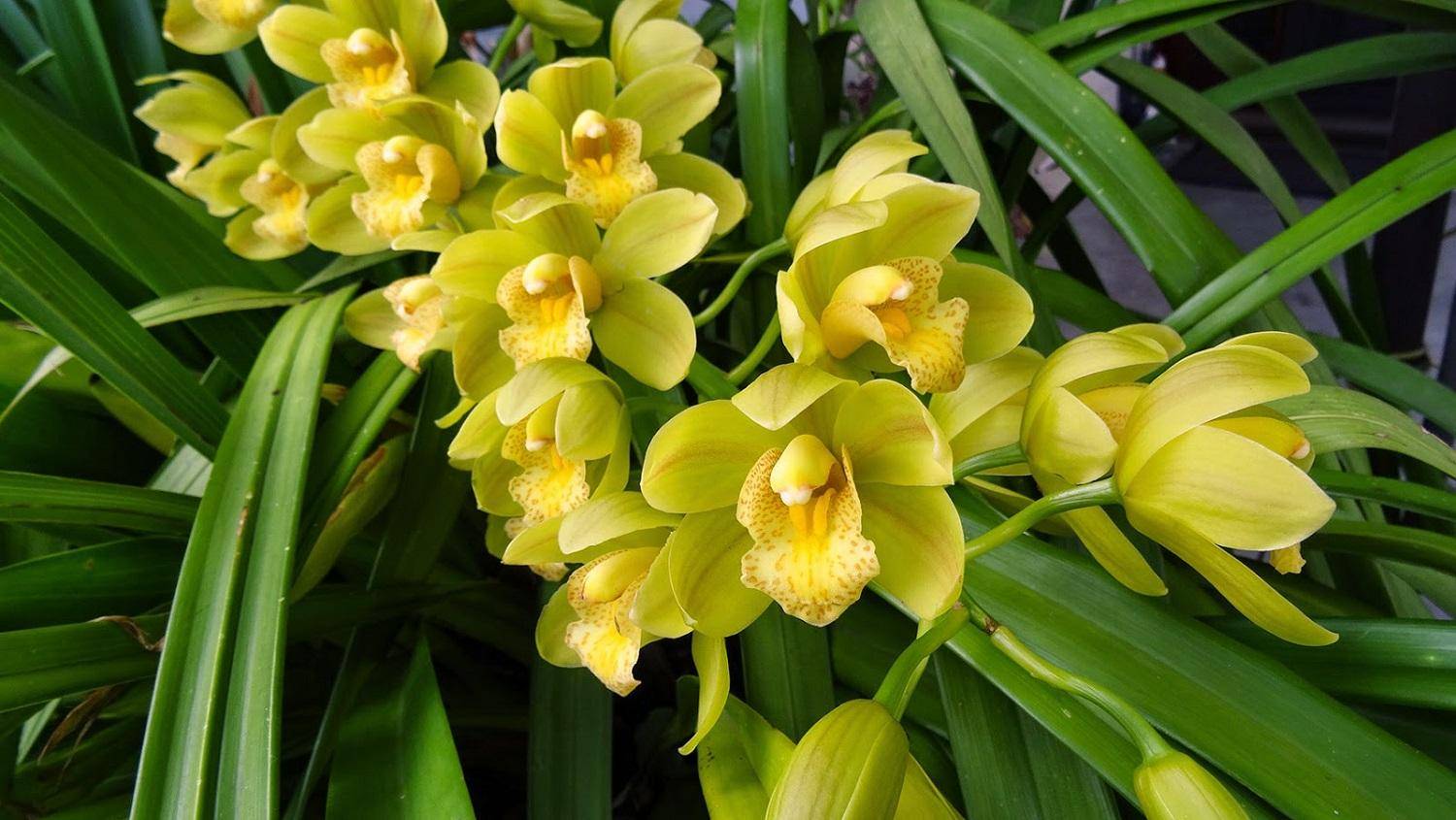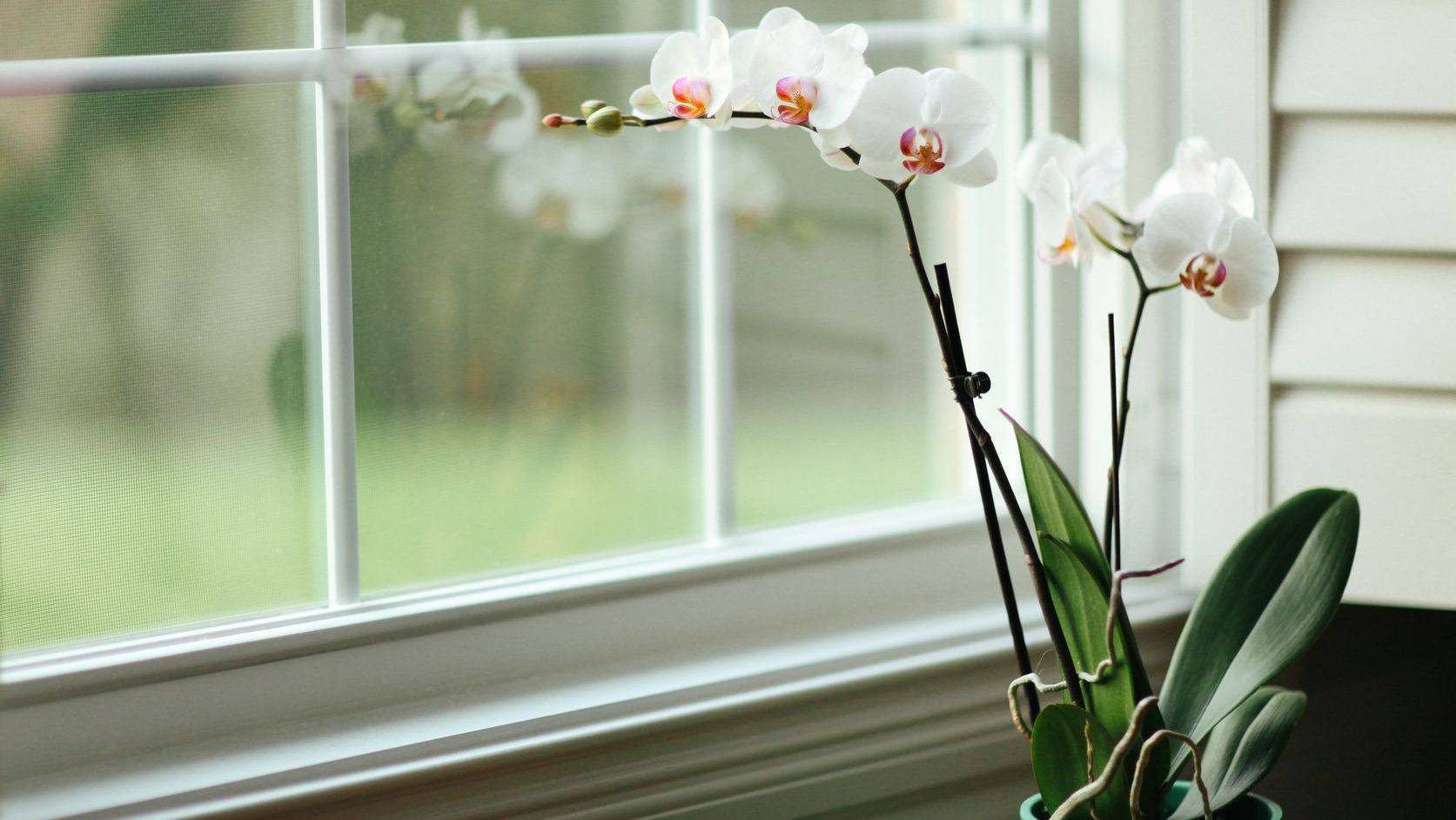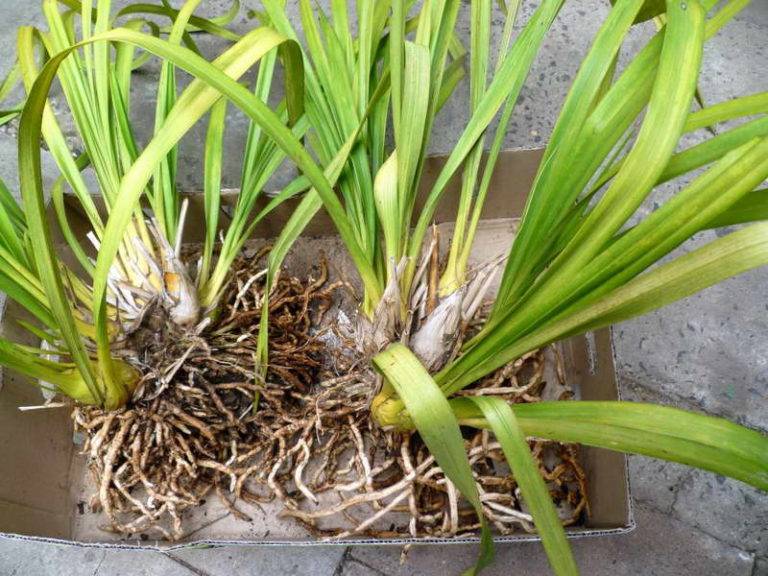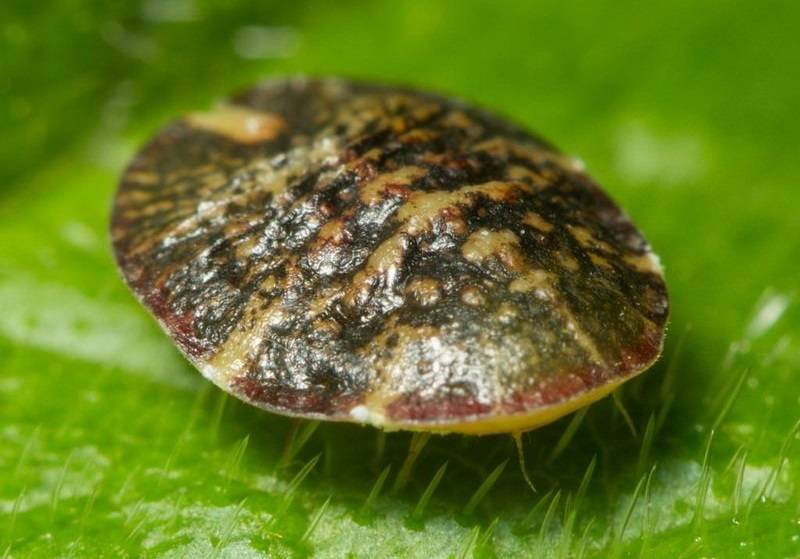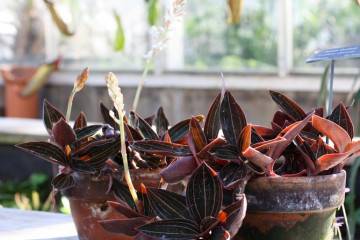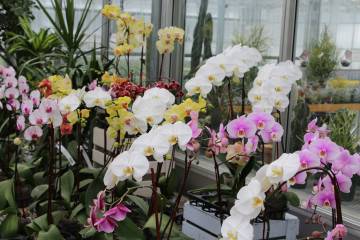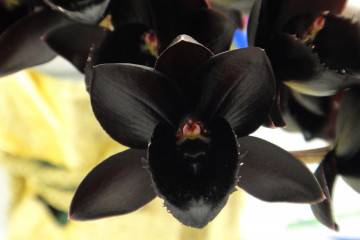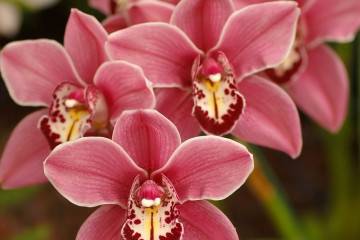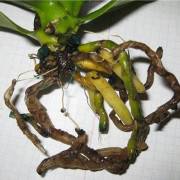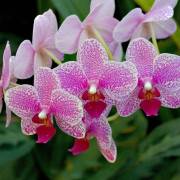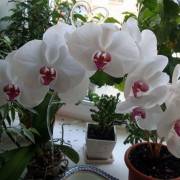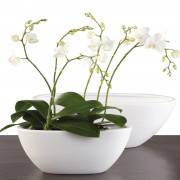Cymbidium orchid - home care
Content:
The cymbidium orchid is a luxurious and most capricious plant in the orchid family for growing at home. To make the plant more pleasing to the eye, it is worth taking proper care of it depending on the season.
What does the cymbidium orchid look like, which family does it belong to
The Cymbidium orchid is an evergreen epiphyte that grows on the crowns and trunks of trees in the tropics, located at an altitude of more than 2 thousand meters above sea level. In rare cases, specimens of this plant can be found on the ground or on the surface of rocks.
Most often, the flower can be found in the wild in the following countries:
- China;
- Vietnam;
- Japan;
- Australia;
- Thailand.
For the first time the culture was described by the Swedish botanist P. U. Svartz in 1799. The leaves of the plant can, on average, reach 25-28 cm in length. Among the varieties, there are oval-shaped leaves with sharp or blunt ends. The leaf plates are colored deep green. By tactile sensations, they are not too hard and fleshy.
The plant is distinguished by the presence of a three-lobed lip. This is an outgrowth in the sepal of variegated color. At the very root, there is a thickened part of the stem - a pseudobulb, where moisture accumulates.
The peduncle of this type of orchid can reach 1.5 m in height. Inflorescences are formed on it in the form of a loose brush or a panicle hanging down. Opened buds vary in size depending on the type of orchid and growing conditions.
Flowers are miniature, reaching 2 cm in diameter, and very large, up to 20 cm in diameter. The color of the petals may also vary. They can be painted yellow, pink, red, brown, cream, yellow-green and other colors.
Depending on the variety, the plant can have a pleasant smell:
- narcissus and lemon;
- jasmine and almond;
- raspberries, honey, etc.
The culture was developed in China almost 2 thousand years ago. The plant received the classification at the beginning of the 14th century in Japan. There it was divided into types and forms. In the 17th century, cymbidium began to be popular with wealthy people. Now such an orchid is available for all growers.
The main varieties and their features
It is estimated that there are 60 types of cymbidium. Below we will consider the features of the main varieties.
Cymbidium Eburneum
Many people know this species as ivory. It is associated with the creamy color of the petals. The large flowers are 12 in diameter. Peduncles reach 30 cm in height. The plant has narrow leaves of a rich green hue. Thick bulbs are stem-shaped. The scent of the flower is reminiscent of lilac. The species is native to China and Myanmar.
Cymbidium Ice Cascade
It is an orchid with belt-like leaves and hanging inflorescences. This species is considered to be small-flowered specimens. The flowers are painted in a snow-white shade. The height of the bush varies between 40-70 cm, and its volume is 50-60 cm.The species is common in the wild nature of Indochina.
Cymbidium Dayanum
The curved narrow leaves of the plant of a bright green hue have pointed tops. Their length can vary between 30-60 cm. The length of the peduncle is 30 cm. Up to 15 buds can appear on the flower arrow.
Petals with sepals of a pale cream shade with a purple central vein. At the white lip, the anterior lobe is strongly twisted backward. The species is widespread in India and Thailand.
Cymbidium Insigne
It is a meter tall plant with hard and curved leaves. The height of the peduncle is 75 cm. The color of the petals can be white or pale pink with red spots. The anterior lobe of the lip is curved backward with a wavy edge. Inflorescences are collected from 9-15 flowers, individually reaching 7-8 cm in diameter. Representatives of white cymbidium live in Thailand, Vietnam and China.
Cymbidium Kiwi Midnight
Compact orchid with leathery narrow belt-like leaves and multi-flowered inflorescences. The flowers are collected in dark burgundy brushes with a shade of violet-lilac. The height and volume of the orchid is 30-40 cm. The green bush of the plant is luxurious and powerful. Native habitat - Indochina.
Cymbidium Giant (Giganteum)
The leaves have a linear-lanceolate type. They have pointed ends. The length of one leaf is 60 cm. There are scaly leaves on the ovoid bulb. Strong massive peduncle reaches a maximum of 60 cm in height. Up to 15 buds are formed on it. The flower petals have a yellow-green tint. The diameter of the bud is 12 cm. The creamy wavy lip may have reddish-brown spots. The habitat in the wild is the Himalayas.
Cymbidium Lowianum
It is an orchid with linear leaves, reaching 1 m in height. The length of the leaf is 75 cm. The diameter of one flower is 20 cm. The inflorescence is multi-flowered. The color of the sepals and petals is yellow-green. The three-lobed lip, colored in dark crimson, has a yellow outline along the edge of the middle lobe. The birthplace of the flower is Burma.
Features of caring for a flower at home
The plant needs to create a favorable microclimate. This will ensure rapid growth and abundant flowering of the plant. Must get cymbidium care at home.
Temperature
The optimum room temperature for a flower is from +18 to +22 degrees. If in the summer period the temperature exceeds +27 degrees, then the bush will be greatly depleted. In winter, it is permissible to drop the temperature to + 15- + 18 degrees during the daytime, and at night - up to +12 degrees. It is important to ensure that daily temperature fluctuations do not exceed + 3- + 4 degrees.
Lighting
The culture belongs to the light-loving. However, direct sunlight is contraindicated for the plant. In winter, the cymbidium flower can be placed on the windowsill. Artificial lighting can be used if necessary. Phytolamps are suitable for this.
In summer, the bush should be placed in the back of the room, shading from the midday sun. Daylight regulation should be gradual. Otherwise, the flowering process will stop and the leaves will be discarded.
Humidity
An orchid needs high air humidity all year round. It is recommended to spray the flower regularly. Do not allow water to come into contact with leaves and flowers. For this, purified soft water is used. The pot can be placed on a pallet with damp expanded clay or placed next to the aquarium.
Top dressing
Throughout the year, the plant is fertilized with mineral complexes for orchids. During the period of regrowth of new foliage, nitrogenous fertilizers are used. Before flowering, the nitrogen content of the fertilizer is minimized and the potassium content is increased.The finished solution is poured under the bush after watering with plain water.
Watering
The primer requires moisture as the top layer dries. In summer, watering the orchid should be abundant. Water the flower 2 times a week under intense lighting with water at room temperature. Water contact with the bulb is not permissible. After 15-20 minutes. after watering, excess water is removed from the pallet.
During the resting period, the frequency of watering is reduced. The procedure is carried out no more than once a month.
Soil and pruning
The bush is suitable for special store soil for orchids. You can also independently obtain a substrate from the bark of conifers, sphagnum, expanded clay, charcoal and leafy earth. The plant does not need special pruning. Only dried and damaged leaves can be removed.
When and how it blooms
Flowering times may vary depending on the species. The plant can bloom at any time of the year. Usually, a new arrow of the peduncle is formed in the summer season closer to August. The orchid will need a special support to help the plant withstand the weight of the flowers.
The successive opening of the buds begins from the bottom of the peduncle and continues at its top. The flowering time is 2-6 months. The number of flowers can be up to 30 pieces.
Some growers may wonder why the cymbidium does not bloom and what to do in this case. The flowering of a plant will not begin if you do not create the right conditions for it and take care of proper nutrition in advance.
The plant will be made to bloom:
- day and night temperature drops of +5 degrees;
- bright diffused light;
- potash fertilizers.
How the cymbidium orchid reproduces
An orchid can be propagated by division or by seed. At home, only the first method is applicable, since it is much easier and more convenient.
Step-by-step instructions for multiplying a flower by division:
- Divide the root into pieces with a sharp knife treated with an antiseptic. Each of the parts should have 2 green bulbs and one old brown shade.
- Remove the soil and rinse the root parts under running water.
- Prune healthy roots to 10 cm and remove unsuitable ones.
- Treat damaged seedlings with activated carbon.
- Plant in small pots with moist, cooked soil.
Growing a flower from seed is a difficult and costly process. For seed germination at home, special conditions are needed, including a strict temperature regime, humidity and acidity. However, the fulfillment of the conditions does not at all guarantee successful reproduction. The survival rate of sprouts is very low.
Transfer
Before transplanting an orchid, you need to take care of the pot. The best option is a new plastic pot with drainage holes 3-5 cm larger than the old one. Miniature specimens grow well in pots 1-2 cm larger than the previous ones.
Instructions on how to transplant:
- Fill the bottom of the pot with a substrate previously soaked in water.
- Remove the orchid from the old container and clean its roots from the substrate. If necessary, cut off diseased parts of the plant.
- Carefully place the bush in a new container, straightening the roots.
- Cover with substrate and tamp.
After transplanting, the cymbidium should be in a dark and cool place with a minimum level of humidity.
Diseases and pests
The orchid can suffer from the following diseases:
- chlorosis - the appearance of yellow streaks on the foliage;
- viral mosaic (fatal) - twisting of foliage and deformation of flowers;
- Fusarium wilting - the appearance of black spots at the junction of the leaf and stem.
Common pests that feed on orchids include aphids and scale insects.
The Cymbidium orchid is a great home decoration. The variety of its species will help you decide which specimen is most suitable for growing.
